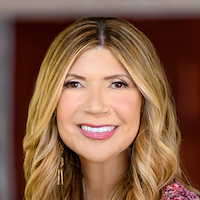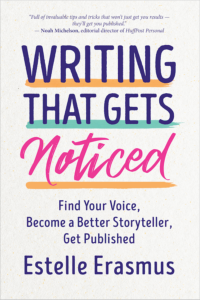
Today’s post is excerpted from Writing That Gets Noticed: Find Your Voice, Become a Better Storyteller, Get Published by Estelle Erasmus.
Writing an opinion piece (or op-ed) about a topic in the news or in the zeitgeist is one way to get the attention of editors, even if you are not an experienced writer. Almost all news outlets have op-ed sections, where writers not affiliated with the publication’s editorial board can contribute. Many online publications feature op-eds as well. (Fun fact: Op-ed is short for “opposite the editorial page,” and not “opinion.”)
It always helps if you can tie your personal experience to the topic you want to write about. When Charlize Theron was in the news because someone called the police on her while she was disciplining her small child, it enraged me, and I published an opinion piece in a parenting publication about what my reaction would be should someone do that to me. I wrote about why my husband does the laundry, and should, for the Washington Post, because research showed that fathers who participated in housework—like my husband—had a positive impact on their daughters’ health, happiness, and future success. And I wrote for Romper about how sheltering in place during the pandemic removed all the usual worries about parenting.
Op-eds aim to persuade the reader to accept the writer’s point of view or recommendations. The best op-eds are provocative or counterintuitive: they may be controversial, go against the conventional thinking on a subject, or add fresh perspective to news stories. However, Holly Baxter from the Independent says her publication has banned the word must from op-ed headlines. She recommends crafting a pitch that a reasonable person can disagree with, one that can start a conversation or a debate. For example, “We must do more for starving children” is not a winning op-ed idea because no reasonable person would argue against it.
With an op-ed it’s always good to take an unusual or opposing viewpoint or go against the grain. If everyone agrees, then what would be the point of writing about the topic?
When it comes to arguing for an idea on the page, passion is good; ranting is not. If you are going on and on and making the piece only about you, without making it relatable or providing any new insight or information, then you risk losing your audience. A better bet is to explore the issue while sharing your personal feelings and how they are connected to the problem or solution that others are facing or dealing with, too. It’s a delicate balance.
Give the facts
Op-eds are not long diatribes or soliloquies. They start with an opinion, maybe about something that annoys you, but that opinion needs to be supported by facts. Lay out why your opinion makes sense and support it with data, such as studies, statistics, and poll results. Just make sure you cite primary sources—the original publications or websites that presented the findings.
Have a nose for news
To find inspiration for op-eds, check the daily news on TV, online, or in the newspapers. (Tip from Jane: Memeorandum is a good thing to scan, along with its sister sites on tech and media.) Figure out whether you have something to add to the national conversation or an important point of view and use that as the basis for the piece.
If you can propose solutions to the problem, even better, as I did when I wrote about my distress that Dressbarn was shutting down its brick-and-mortar stores. I wrote, “Dressbarn was the perfect outlet to focus on the midlife market—and the buying power of women in their 40s and 50s—that the chain never really took seriously or tried to explore.” Then I shared how important Dressbarn had been in my life—I wore a Dressbarn dress for my engagement party and another for my bridal shower—and suggested that Dressbarn ignored and didn’t create partnerships with online retailers such as Amazon and QVC or on social media, they didn’t have good mobile technology, and their DB dollars and loyalty codes were too complicated and confusing. This piece was published in AARP’s The Girlfriend. The editor told me she had gotten a lot of comments about the situation, and my op-ed landed in her lap at the perfect time.
Adapt an essay into an op-ed
You might have written up something as a personal essay, but if you are new to publishing, it might be easier for you to get it published as an op-ed. For example, I wrote my New York Times piece “Singing My Dad Back to Me” as an essay, but it could have also been an op-ed, using research to support my premise that music helps Alzheimer’s patients, like my dad, stay connected to what’s around them. My student Jennie Burke wrote her New York Times piece “Defying the Family Cycle of Addiction” as an essay, with reported elements about her family’s history of opioid addiction and her concern about her daughter being prescribed opioids after surgery, but it could have easily been an op-ed on how to protect teens from addiction.
If you have a long essay that might work as an op-ed, try to shorten it to 600-700 words.
Consider a call to action
After you have laid out your opinion and supported it with facts and information, you need to conclude. A good way to do it is to circle back to something you said in the intro of your piece and add one new insight or thought. The most persuasive op-eds often end with a call to action: a rallying cry, a way for readers to join the cause or at least think about it.
For example, in an op-ed I wrote for the Independent about Britney Spears—about the army of lawyers, researchers, data experts, and other professionals (called the Britney Army) supporting her in her fight against the conservatorship she was under for thirteen years—I ended my piece with a quote from someone involved in the movement calling for the government to fund home aides who leave at night. This would be an alternative to providing grants to states that make it easy for unscrupulous people to get involved in corrupt conservatorships and commit conservatorship abuse.
Get paid
Most publications pay for op-eds. For information on op-ed fees, check out the site Who Pays Writers? For a list of US newspapers that publish op-eds, check out the OpEd Project.
Seize the moment
Although writers can pitch and submit an op-ed whenever they have an opinion on a situation or issue, it’s important to know that editors frequently send out calls for pitches for op-eds and other short pieces on social media or to writers they have worked with, pegged to new TV shows, movies, or books. Often these “rapid-response” editors commission pieces only a day or so before they run. The key to getting noticed is to get in first. The news cycle moves fast, so when you find a topic you want to write about, act quickly.

Estelle Erasmus, author of Writing That Gets Noticed: Find Your Voice, Become a Better Storyteller, Get Published (June 2023), is a professor of writing at New York University, the host of the Freelance Writing Direct podcast, and former “All About the Pitch” columnist for Writer’s Digest where she also teaches classes on pitching, personal essay writing, and getting started in writing. She has written about a variety of subjects (health, beauty, fitness, publishing, business, travel) for numerous publications. Her articles for the New York Times and Washington Post have gone globally viral (with more than 500 comments on her New York Times piece, “How to Bullyproof Your Child”). She has appeared on Good Morning America and has had her articles discussed on The View. She has also taught, coached, and mentored many writers who have gone on to be widely published. She received the 2023 NYU School of Professional Studies Teaching Excellence Award, is an American Society of Journalists and Authors award winner, and was a cast member in the inaugural New York City production of the Listen to Your Mother storytelling show. Learn more at www.EstelleSErasmus.com and register for her latest classes. Also, follow Estelle on Instagram, TikTok, and X, and sign up for her Substack.


Estelle,
Thank you for the post. This was actionable and helpful. I’m sure you could do an entire followup post on pitching op-eds, but would you mind sharing a few tips?
Best,
Kristi
As the author of many op eds placed either for myself or written and placed on behalf of clients back in the day, this advice is spot on.
Very helpful advice, as always, by Estelle.
Wow! I absolutely loved this piece for its practical advice on how to publish an Op-Ed and grow as a writer. I published Op-Eds previously, but had not considered this route in my newest journey as a writer. This is definitely something I will consider doing moving forward and I already have a few ideas floating around in my head!